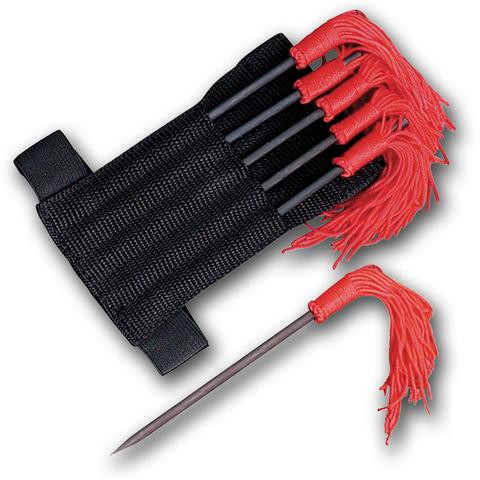Types of Ninja Throwing Stars: A Complete Guide

Ninja throwing stars, known as shuriken, are one of the most recognizable weapons in martial arts history. These compact, versatile tools were traditionally used by samurai and ninjas for distraction, deterrence, and even tactical attacks.
If you're interested in martial arts weapons, throwing sports, or simply want a unique addition to your collection, understanding the different types of shuriken will help you choose the best throwing star for your needs.
What Are Throwing Stars?
Shuriken (手裏剣) translates to “hidden hand blade” and refers to small, star-shaped weapons designed for throwing. Unlike swords or knives, shuriken were not primary weapons but were instead used to:
✅ Disorient opponents in combat.
✅ Distract and delay attackers.
✅ Deliver poisons or fire when coated with toxins or wrapped in burning material.
✅ Strike from a distance before engaging in close combat.
Today, throwing stars are popular for martial arts training, target practice, and collectors of traditional ninja gear.
Types of Throwing Stars (Shuriken)
Shuriken come in a variety of shapes and sizes, each with its own advantages. Below are the most common types of throwing stars you’ll find:
1. Hira-Shuriken (Flat Throwing Stars)
Also known as “ninja stars”, these are the classic multi-pointed designs most people recognize.
♦ Shape: Circular, flat, with 3 to 8 points.
♦ Use: Best for balanced throws and consistent spinning.
♦ Example: 4-Point Throwing Star – Great for beginners and casual practice.
2. Bo-Shuriken (Throwing Spikes)
A lesser-known but highly effective throwing weapon, bo-shuriken are straight spikes or nails rather than star-shaped.
♦ Shape: Long and narrow (like a dart or short rod).
♦ Use: Can be thrown overhand or underhand, piercing targets with force.
♦ Example: Not commonly available but can be improvised with throwing knives.
3. Senban-Shuriken (Square Blades)
A unique style of throwing star with a square shape, often heavier and designed for impact.
♦ Shape: Square, flat edges, typically 4 sharp corners.
♦ Use: More impact force, ideal for sticking into wood and targets.
♦ Example: Heavy Steel Throwing Stars – Durable and designed for practice.
4. Multi-Pointed Stars
Some throwing stars feature 5, 6, or even 8 points, designed to increase the chances of a successful hit.
♦ Shape: Symmetrical, with more sharp points.
♦ Use: Best for target practice, ensuring a hit from any angle.
♦ Example: 8-Point Throwing Star Set – Excellent for martial arts training.
Choosing the Best Throwing Star for You
When selecting a ninja star, consider the following:
| Factor | What to Look For |
|---|---|
| Skill Level | Beginners should start with 4-point or 6-point stars for easier handling. |
| Material | Stainless steel stars offer durability, while lightweight aluminum stars are better for speed. |
| Blade Edges | Sharp-edged stars require careful handling, while dull practice stars are safer for beginners. |
| Weight & Balance | Heavier stars provide stability, while lighter stars spin faster. |
How to Throw a Ninja Star (Basic Steps)
1️⃣ Grip the star: Hold it between your thumb and first two fingers with a firm but relaxed grip.
2️⃣ Stand with balance: Keep your feet shoulder-width apart, facing the target.
3️⃣ Aim & release: With a smooth, controlled motion, flick your wrist and release toward the target.
4️⃣ Practice & adjust: Experiment with different angles and distances for better accuracy.
✦ Want to perfect your technique? Browse our full How to Throw a Throwing Star Guide to help perfect your training.
Legal Considerations for Throwing Stars
Before purchasing or carrying ninja stars, check your local laws. Some states have restrictions on possession, sale, or public carrying of throwing stars. Always use them responsibly and for legal purposes like martial arts training or collecting.
Check local regulations before buying.
Final Thoughts: Mastering the Art of the Throwing Star
Throwing stars have a rich history and remain popular for martial arts, collecting, and self-defense training. Whether you’re a beginner looking for an easy-to-throw ninja star or an experienced user seeking a high-quality set, TBOTECH has you covered.
✦ Upgrade your collection today! Browse our full selection of Throwing Stars & Ninja Gear now.
Add your comment now!
Post CommentRecent posts
-
03/12/2025Best Stun Guns for Self-Defense in 2025
-
03/11/2025How to Prevent Kidnapping – Top Safety Tips
-
03/11/2025What Do Rapists Look For? 10 Red Flags to Avoid


